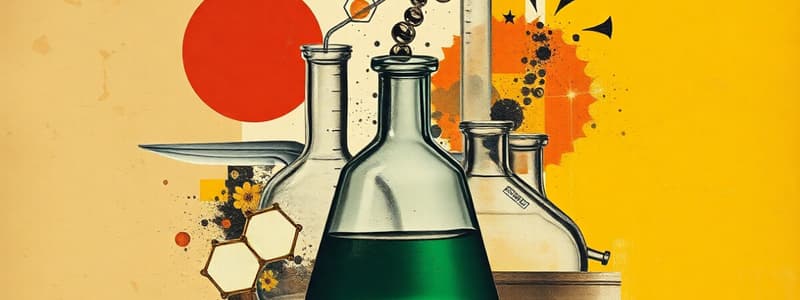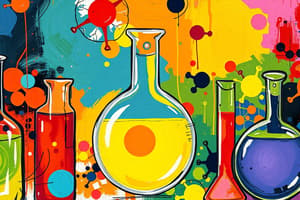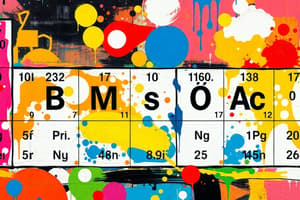Podcast
Questions and Answers
Which of the following is a compound?
Which of the following is a compound?
- Carbon (C)
- Salt water
- Oxygen (O2)
- Water (H2O) (correct)
The number of protons in an atom is always equal to the number of neutrons in a neutral atom.
The number of protons in an atom is always equal to the number of neutrons in a neutral atom.
False (B)
What is the central core of an atom called?
What is the central core of an atom called?
nucleus
The ______ is the number of protons in the nucleus of an atom.
The ______ is the number of protons in the nucleus of an atom.
Match the following terms with their descriptions:
Match the following terms with their descriptions:
What are the subatomic particles that orbit the nucleus of an atom?
What are the subatomic particles that orbit the nucleus of an atom?
Mixtures cannot be separated by physical means.
Mixtures cannot be separated by physical means.
What particles determine the mass number of an atom?
What particles determine the mass number of an atom?
Flashcards
What is an element?
What is an element?
A pure substance made up of only one type of atom. Cannot be broken down into simpler substances.
What is a compound?
What is a compound?
A substance formed when two or more different elements chemically combine. Has properties distinct from its constituent elements.
What is a mixture?
What is a mixture?
A combination of two or more substances (elements or compounds) physically mixed together, but not chemically bonded.
What is an atom?
What is an atom?
Signup and view all the flashcards
What are protons?
What are protons?
Signup and view all the flashcards
What are neutrons?
What are neutrons?
Signup and view all the flashcards
What are electrons?
What are electrons?
Signup and view all the flashcards
What is the atomic number (Z)?
What is the atomic number (Z)?
Signup and view all the flashcards
Study Notes
Elements, Compounds, and Mixtures
- An element is a pure substance composed of only one type of atom.
- Elements cannot be broken down into simpler substances.
- Elements are represented by chemical symbols, such as O for oxygen or H for hydrogen.
- Examples of elements: oxygen (O2), carbon (C)
- A compound is formed when two or more different elements chemically combine.
- Compounds have distinct and unique properties different from the elements that make them up.
- Compounds can be represented by chemical formulas, such as H2O for water or CO2 for carbon dioxide.
- Compounds cannot be separated physically; chemical reactions are needed to break them down into their individual elements.
- Examples of compounds: water (H2O), carbon dioxide (CO2)
- A mixture is a combination of two or more substances (elements or compounds) physically mixed together but not chemically bonded.
- The components in a mixture retain their individual properties and can be separated by physical means, such as filtration or distillation.
- Example: Salt water
Atoms and Subatomic Particles
- An atom is the smallest unit of matter that makes up everything around us.
- Atoms are the basic building blocks of all substances.
- Atoms consist of subatomic particles: protons, neutrons, and electrons.
- The nucleus is the central core of an atom, containing protons and neutrons.
- Protons are positively charged particles found in the nucleus.
- Neutrons are neutral particles (no charge) also found in the nucleus.
- Electrons are negatively charged particles that orbit the nucleus in specific energy levels or shells.
- Electrons are much lighter than protons and neutrons.
Atomic Structure
- The atomic number (represented by Z) is the number of protons in the nucleus of an atom.
- The number of protons always equals the number of electrons in a neutral atom.
- The atomic number helps identify an element's location on the periodic table.
- The mass number (represented by A) is the total number of protons and neutrons in the nucleus of an atom.
- The mass number represents the total mass of the atom.
- The mass number is equal to the number of protons plus the number of neutrons.
- Relative atomic mass is the average mass of all the isotopes of an element, rounded to the nearest whole number for simplicity.
- The mass number is close to the relative atomic mass, and for most elements, the relative atomic mass can be used as a substitute for the mass number.
- The number of neutrons can be calculated by subtracting the atomic number from the mass number.
Periodic Table
- The periodic table lists elements with their atomic number at the top and the relative atomic mass at the bottom.
Studying That Suits You
Use AI to generate personalized quizzes and flashcards to suit your learning preferences.





